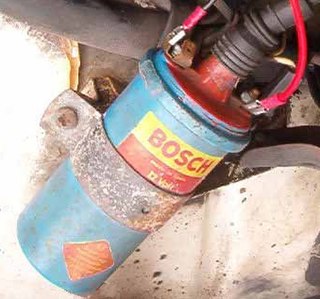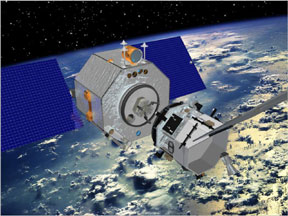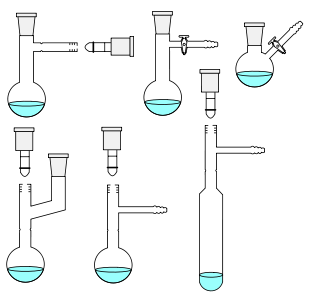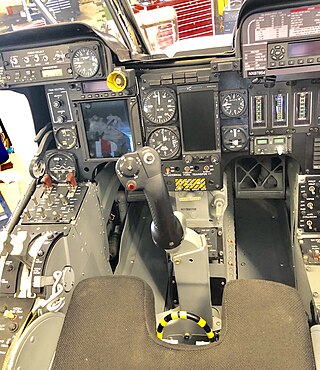
Titan was a family of United States expendable rockets used between 1959 and 2005. The Titan I and Titan II were part of the US Air Force's intercontinental ballistic missile (ICBM) fleet until 1987. The space launch vehicle versions contributed the majority of the 368 Titan launches, including all the Project Gemini crewed flights of the mid-1960s. Titan vehicles were also used to lift US military payloads as well as civilian agency reconnaissance satellites and to send interplanetary scientific probes throughout the Solar System.

Hydrazine is an inorganic compound with the chemical formula N2H4. It is a simple pnictogen hydride, and is a colourless flammable liquid with an ammonia-like odour. Hydrazine is highly toxic unless handled in solution as, for example, hydrazine hydrate.

A hypergolic propellant is a rocket propellant combination used in a rocket engine, whose components spontaneously ignite when they come into contact with each other.

STS-2 was the second Space Shuttle mission conducted by NASA, and the second flight of the orbiter Columbia. The mission, crewed by Joe H. Engle and Richard H. Truly, launched on November 12, 1981, and landed two days later on November 14, 1981. STS-2 marked the first time that a crewed, reusable orbital vehicle returned to space. This mission tested the Shuttle Imaging Radar (SIR) as part of the OSTA-1 payload, along with a wide range of other experiments including the Shuttle robotic arm, commonly known as Canadarm. Other experiments or tests included Shuttle Multispectral Infrared Radiometer, Feature Identification and Location Experiment, Measurement of Air Pollution from Satellites, Ocean Color Experiment, Night/Day optical Survey of Lightning, Heflex Bioengineering Test, and Aerodynamic Coefficient Identification Package (ACIP). One of the feats accomplished was various tests on the Orbital Maneuvring System (OMS) including starting and restarting the engines while in orbit and various adjustments to its orbit. The OMS tests also helped adjust the Shuttle's orbit for use of the radar. During the mission, President Reagan called the crew of STS-2 from Mission Control Center in Houston.

The Space Shuttle Solid Rocket Booster (SRB) was the first solid-propellant rocket to be used for primary propulsion on a vehicle used for human spaceflight. A pair of these provided 85% of the Space Shuttle's thrust at liftoff and for the first two minutes of ascent. After burnout, they were jettisoned and parachuted into the Atlantic Ocean where they were recovered, examined, refurbished, and reused.

American Airlines Flight 96 (AA96/AAL96) was a regular domestic flight operated by American Airlines from Los Angeles to New York via Detroit and Buffalo. On June 12, 1972, the left rear cargo door of the McDonnell Douglas DC-10-10 operating the flight blew open and broke off en route between Detroit and Buffalo above Windsor, Ontario; the accident is thus sometimes referred to as the Windsor incident, although according to the NTSB it is an accident, not an incident.

An ignition coil is used in the ignition system of a spark-ignition engine to transform the battery voltage to the much higher voltages required to operate the spark plug(s). The spark plugs then use this burst of high-voltage electricity to ignite the air-fuel mixture.

Morris Richard Jeppson was a Second Lieutenant in the United States Army Air Forces during World War II. He served as assistant weaponeer on the Enola Gay, which dropped the first atomic bomb on the city of Hiroshima, Japan on August 6, 1945.
UH 25 is a fuel mixture for rockets. It was developed for the European Ariane 2–4 launch vehicles.
In fencing, a body cord serves as the connection between a fencer and a reel of wire that is part of a system for electrically detecting that the weapon has touched the opponent. There are two types: one for epee, and one for foil and sabre.

Orbital Express was a space mission managed by the United States Defense Advanced Research Projects Agency (DARPA) and a team led by engineers at NASA's Marshall Space Flight Center (MSFC). The Orbital Express program was aimed at developing "a safe and cost-effective approach to autonomously service satellites in orbit". The system consisted of two spacecraft: the ASTRO servicing satellite, and a prototype modular next-generation serviceable satellite; NEXTSat. The mission launched from Cape Canaveral Air Force Station on 8 March 2007, aboard an Atlas V expendable launch vehicle. The launch was part of the United States Air Force Space Test Program STP-1 mission.

STS-123 was a Space Shuttle mission to the International Space Station (ISS) which was flown by Space Shuttle Endeavour. STS-123 was the 1J/A ISS assembly mission. The original launch target date was February 14, 2008, but after the delay of STS-122, the shuttle was launched on March 11, 2008. It was the twenty-fifth shuttle mission to visit the ISS, and delivered the first module of the Japanese laboratory, Japanese Experiment Module (Kibō), and the Canadian Special Purpose Dexterous Manipulator, (SPDM) Dextre robotics system to the station. The mission duration was 15 days and 18 hours, and it was the first mission to fully utilize the Station-to-Shuttle Power Transfer System (SSPTS), allowing space station power to augment the shuttle power systems. The mission set a record for a shuttle's longest stay at the ISS.

A Schlenk flask, or Schlenk tube, is a reaction vessel typically used in air-sensitive chemistry, invented by Wilhelm Schlenk. It has a side arm fitted with a PTFE or ground glass stopcock, which allows the vessel to be evacuated or filled with gases. These flasks are often connected to Schlenk lines, which allow both operations to be done easily.
This is the timeline for STS-121, the mission to the ISS.
Fregat (Russian: Фрегат, frigate) is an upper stage developed by NPO Lavochkin in the 1990s, which is used in some Soyuz and Zenit launch vehicles, but is universal and can be used as a part of a medium and heavy class launch vehicles. Fregat became operational in February 2000. Its liquid propellant engine uses UDMH and N2O4. Fregat's success rate is 97.8% (with 2 failures in 93 launches), which makes it one of the most reliable upper stages in the world. Fregat has successfully delivered more than 300 payloads into different orbits. It remains the only upper stage in the world that can place its payload into 3 or more different orbits in a single launch.

In rocketry, range safety or flight safety is ensured by monitoring the flight paths of missiles and launch vehicles and implementing various measures to protect nearby people, buildings and infrastructure if one malfunctions or veers off course mid-flight. Usually, a range safety officer (RSO) commands the flight or mission to end by sending a signal to the flight termination system (FTS) aboard the rocket. This activates explosives placed in specific parts of the vehicle to eliminate any means with which it could endanger anyone or anything on the ground. Flight termination could also be triggered autonomously by a separate computer unit on the rocket itself.
In military munitions, a fuze is the part of the device that initiates function. In some applications, such as torpedoes, a fuze may be identified by function as the exploder. The relative complexity of even the earliest fuze designs can be seen in cutaway diagrams.

Aircraft systems are those required to operate an aircraft efficiently and safely. Their complexity varies with the type of aircraft.
Nitrous oxide fuel blend propellants are a class of liquid rocket propellants that were intended in the early 2010s to be able to replace hydrazine as the standard storable rocket propellent in some applications.

Aerojet Rocketdyne is an American manufacturer of rocket, hypersonic, and electric propulsive systems for space, defense, civil and commercial applications. Headquartered in Sacramento, California, the company is owned by Aerojet Rocketdyne Holdings. Aerojet Rocketdyne was formed in 2013 when Aerojet and Pratt & Whitney Rocketdyne were merged, following the latter's acquisition by GenCorp from Pratt & Whitney. On April 27, 2015, the name of the holding company, GenCorp, was changed from GenCorp, Inc. to Aerojet Rocketdyne Holdings, Inc.













